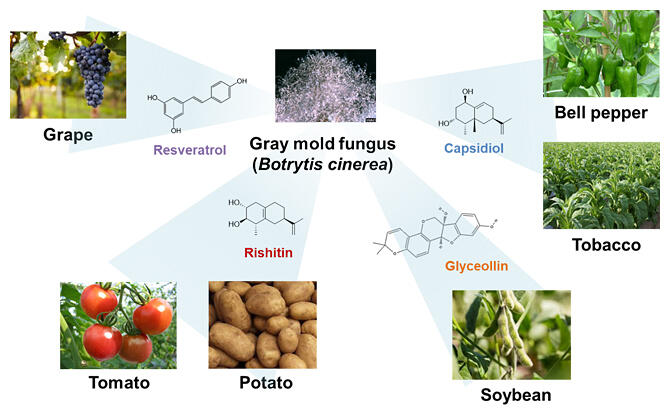A research group consisting of Associate Professor Daigo Takemoto, graduate student Teruhiko Kuroyanagi and Professor Makoto Ojika of the Graduate School of Bioagricultural Sciences, Nagoya University, and their colleagues has announced that they have clarified the mechanism by which Botrytis cinerea (gray mold) effectively infects a diverse range of plants (polyxeny). When the group investigated how antimicrobial substances from plants act on Botrytis cinerea, they found that it achieves infection by evading the defense mechanisms of a diverse range of plants, including antimicrobial substances, through different mechanisms. It is hoped that this will lead to the development of new control methods for the mold. The group's results were published on December 21 in the international science journal PNAS Nexus.

Provided by Nagoya University
Botrytis cinerea has the ability to infect an extremely diverse range of plant species (polyxeny), and it has been calculated that it causes trillions of yen of damage each year in agriculture around the world. Most plant pathogens cause disease by infecting a specific type of plant, but Botrytis cinerea infects over 1,400 types of plant, including fruits, vegetables and flowering plants such as tomatoes, eggplants, bell peppers, strawberries, grapes, roses and Western orchids. It is thought that it infects plants by breaking through their defense mechanisms, including the antimicrobial substances created by each type of plant. However, it was not known how it achieves this polyxeny.
This research group focused on the response of Botrytis cinerea to antimicrobial substances produced by plants to resist pathogens. Plants activate their resistance due to attacks from pests and pathogens - for example, tomatoes and potatoes produce rishitin and peppers produce capsidiol, which are sesquiterpenoid (terpene-based) antimicrobial substances.
It was known that these antimicrobial substances are altered when added to Botrytis cinerea: after dehydrogenation and oxidation, capsidiol is metabolized into epoxy capsenone, which is harmless to the mold, and rishitin is oxidized and broken down into epoxy- or hydroxyrishitins, which are less toxic.
To explore the Botrytis cinerea genes associated with this metabolism, the group added capsidiol, rishitin and resveratrol (an antimicrobial substance from grapes) each to it and explored the changing expression of the genes after 24 hours using RNA-seq analysis.
From this, they learned that capsidiol, rishitin and resveratrol are all broken down using different enzymes. Moreover, among the approximately 12,000 genes of Botrytis cinerea, only a small number - 20 or so - were activated by each of these antimicrobial substances. There were several genes that activated for two antimicrobial substances, while there were none that activated for all three antimicrobial substances, so it is thought that different genes activate for each antimicrobial substance.
Moreover, when the group took a closer look at Botrytis cinerea's response to capsidiol, they discovered BcCPDH, the capsidiol dehydrogenase gene. They confirmed that a strain without this gene could not detoxify capsidiol, and its pathogenicity toward pepper was reduced. By inoculating different plant species with this strain, the group ascertained that its pathogenicity was not reduced outside of capsidiol-producing plant species. This gene was activated when Botrytis cinerea invades plants.
Moreover, when the group explored the distribution of homologs of BcCPDH in the world of fungi, their research indicated the possibility that among related species (Botrytis), they are only present in Botrytis cinerea, as this species alone underwent special evolution. As several evolutionarily distinct pathogens have very similar genes, it seems that it acquired the BcCPD gene by horizontal transfer from other microorganisms during the process of evolution.
In addition, the gene that oxidizes rishitin and the gene that plays the role of an efflux pump that removes rishitin from cells when rishitin interacts with this pathogen are also specific genes.
The group learned that when Botrytis cinerea infects diverse plants, it discerns the antimicrobial substance originally produced by the plant to repel pathogens and activates the appropriate infection mechanism to make infection possible.
Takemoto commented on this result, "I believe that our research outcomes will contribute to the development of extremely safe and effective RNA agrichemicals that do not damage people, animals or environmental microbes. We have already started analyzing the effectiveness of RNA agrichemicals in the lab."
Journal Information
Publication: PNAS Nexus
Title: Botrytis cinerea identifies host plants via the recognition of antifungal capsidiol to induce expression of a specific detoxification gene.
doi.org/10.1093/pnasnexus/pgac274
This article has been translated by JST with permission from The Science News Ltd. (https://sci-news.co.jp/). Unauthorized reproduction of the article and photographs is prohibited.




